2. 石家庄经济学院资源学院, 石家庄 050031
3. 中石油大港油田公司, 天津 300280
4. 陕西地矿第二综合物探大队, 西安 710016
2. College of Resources, Shijiazhuang University of Economics, Shijiazhuang 050031, China
3. PetroChina Dagang Oil-field Company, Tianjin 300280, China
4. The No. 2 Comprehensive Geophysical Prospecting Brigade Shaanxi Geological Mining, Xi'an 710016, China
致密油是继页岩气之后全球非常规油气勘探开发的又一新热点(孙赞东等, 2011; 赖锦等, 2015),从2006年Williston盆地ElmCoulee油田Bakken组致密油突破7952 m3/d,2008年Bakken组致密油实现规模开发,到2012年美国致密油产量突破9500×104 t,改变了美国的能源供给格局.中国近几年的勘探开发实践证实,鄂尔多斯盆地三叠系延长组长7段、准噶尔盆地二叠系芦草沟组、四川盆地中-下侏罗统,以及松辽盆地白垩系青山口组-泉头组均发育丰富的致密油资源(Johnstone, 2007; 贾承造等, 2012; 邓继新等, 2015).鄂尔多斯盆地是世界著名的低渗透特低渗透油气勘探与开发基地(邹才能等, 2012),由于具有稳定宽缓的古地貌背景,后期构造变形弱,断层不发育,为致密油藏的形成提供了良好的前提条件.近年来鄂尔多斯盆地陆续建成了十余个致密油勘探开发示范区,单井最高产量达60t/d,成为中国致密油发展最具前景的地区之一.包括鄂尔多斯盆地在内的勘探实践表明:烃源岩评价和源储配置关系分析是致密油藏研究的关键(Johnstone, 2007; 孙赞东等, 2011; 邹才能等, 2011; 贾承造等, 2012),所以,以烃源岩评价为基础,进行砂体结构研究,并寻找块状砂体发育区,精细刻画致密油藏源储配置关系,将为含油性评价提供必要的支撑.
1 烃源岩评价致密油是指夹在或紧邻优质生油层系的致密碎屑岩或碳酸盐岩储层中,未经大规模长距离运移而形成的石油聚集.致密油的形成与烃源岩密切相关,优质、成熟、具有一定厚度和分布范围的优质烃源岩是致密油形成的重要物质基础.
1.1 烃源岩测井识别烃源岩的识别评价是油气地质研究的重要基础工作之一(张小莉和沈英, 1998; Zhang et al., 2009; 郝建飞等, 2012; 杨涛涛等, 2013; 曾溅辉等, 2014; 夏一军等, 2015; 汪少勇等, 2015),由于测井数据具有连续性和高分辨率的特点目前已成为识别烃源岩最常规和重要的技术之一.鄂尔多斯盆地延长组长7段广泛发育优质烃源岩,测井曲线上表现为“四高一低”的特征,即高自然伽马、声波时差、补偿中子和高感应电阻率,低密度.长7段烃源岩岩电关系对比分析表明自然伽马、电阻率、声波时差和密度等多参数对烃源岩反映灵敏.由此采用单项测井参数或多种测井参数组合来识别烃源岩(吉利明等, 2007; Wolela, 2007).其中,深感应电阻率(RILD)与声波时差(AC)曲线组合编绘重叠图是识别烃源岩的常用方法之一,烃源岩富含有机质,导致声波时差增大,电阻率增高,所以曲线反向重叠图中具有明显的幅度差(Passey et al., 1990).深感应电阻率与声波时差曲线重叠图中,纯泥岩层段两种曲线基本重叠无幅度差,烃源岩发育层段由于富含有机质在重叠图上存在幅度差,一般有机质含量越高,其幅度差越明显(图 1).
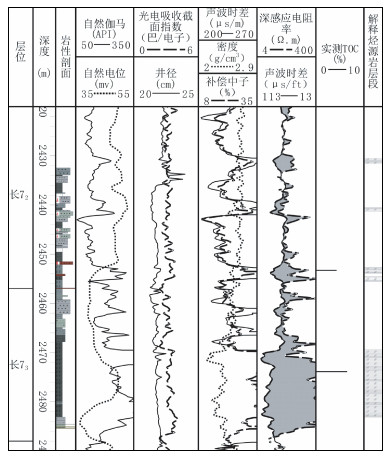
|
图 1 H317井烃源岩测井响应特征 Figure 1 Log characteristics of hydrocarbon source rocks in H317 |
岩心分析结果表明,长7烃源岩有机碳含量(TOC)一般5%~18%,平均13%,在湖盆中心部位烃源岩TOC值一般10%~18%,为长7优质烃源岩发育区.
根据12口井(图 4b)长7段55样品有机碳(TOC)分析结果,对比分析其测井响应特征表明,自然伽马、声波时差、补偿中子、深感应电阻率、密度曲线对有机碳含量均有反映,尤以自然伽马、深感应电阻率和声波时差响应最为灵敏.据其多元线性回归得:

|
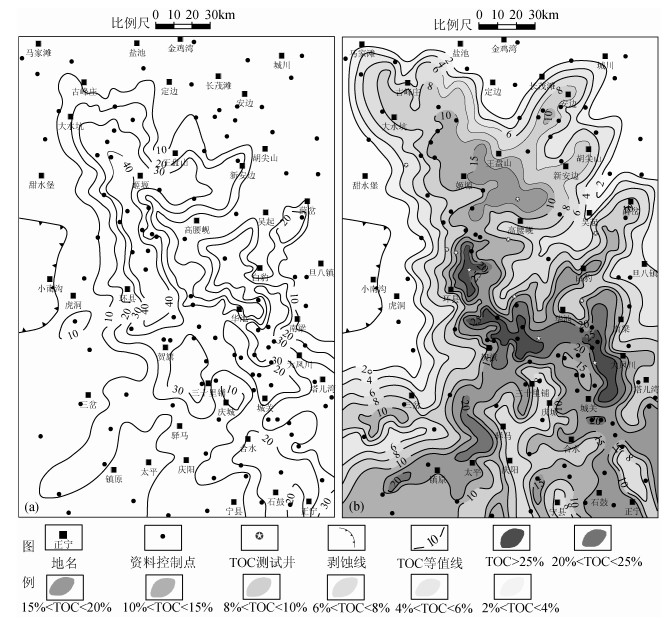
|
图 4 鄂尔多斯盆地烃源岩平面分布特征 Figure 4 Distribution of hydrocarbon source rocks plane in Ordos Basin |
式中:GR-自然伽马值;GRmin-纯泥岩段自然伽马值;Rt-深感应电阻率;Rtmin-纯泥岩段深感应电阻率;AC-声波时差值;ACmin-纯泥岩段声波时差值.利用上述多元线性回归计算TOC值与实测TOC值相关性较好(图 2),其绝对误差最大为2.5%,平均为0.65%,相对误差小于10%.利用多元线性回归方法求取240余口井烃源岩TOC值一般2.0%~20.0%(图 3),与实际分析测试结果吻合.
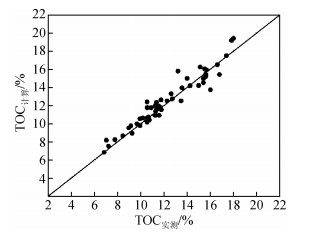
|
图 2 实测有机碳TOC与测井计算TOC关系图 Figure 2 TOC measured-TOCcalculate correlation diagram |
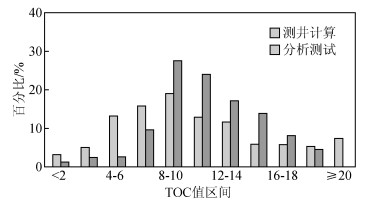
|
图 3 计算TOC分布直方图 Figure 3 The calculated TOC distribution histogram |
参照烃源岩评价标准,结合鄂尔多斯盆地实际情况,建立烃源岩TOC值所对应的测井响应值范围(表 1),以便对缺乏TOC实测资料和低勘探程度地区的评价.
|
|
表 1 鄂尔多斯盆地烃源岩测井评价标准 Table 1 Evaluation standards of tight oil source rocks in the Odors basin |
根据所建立的烃源岩有机碳含量解释模型进行解释并统计烃源岩厚度及其累加厚度,结果表明单井中长7烃源岩累加厚度值大于15 m的区域主要呈北西-南东向展布,庆城-华池一线烃源岩厚度较大,平均厚度30 m左右,累计厚度最大可达70 m;盆地边部地区烃源岩厚度一般小于10 m (图 4a).同时,长7段烃源岩TOC分布具有较强的非均质性(图 4b),TOC大于10%的区域沿姬嫄-贺旗-庆城-合水一带分布,局部地区TOC大于25%.长7烃源岩作为鄂尔多斯盆地主力烃源岩,分布面积达10×104 km2.
2 源储配置关系良好的源储配置关系控制着含油富集区的分布,是形成致密油的重要条件(Zhang et al., 2009; Wang et al., 2010; 付锁堂等, 2010; 姚泾利等, 2013; 赵靖舟等, 2013).鄂尔多斯盆地延长组长7段烃源岩分布连续性较好,厚度较大,分布范围广,镜质体反射率(Ro)在盆地西缘一般0.5%~1.3%,中部1.3%~1.8%,从盆地边缘向盆地内部增高(任战利, 1999; 刘洛夫和金之钧, 2002).任战利等研究表明,鄂尔多斯盆地从中侏罗世(约170 Ma)开始生成油气,130 Ma进入生油高峰(任战利, 1999),生烃持续时间长,总体上为一套成熟的经历了生油高峰期的优质烃源岩,为致密油富集成藏奠定了丰富的物质基础.另一方面,延长组长7段为半深湖-深湖沉积环境,重力流发育,造成了砂体在纵向上具有多层叠置、单层厚度变化大并被烃源岩分隔的特点,砂层上、下与烃源岩紧密接触,延长组长7段致密砂岩成为致密油气的有利富集区.
2.1 砂体结构特征及测井识别砂体结构是单砂体厚度、形态、规模、连续性、水平搭接方式及其纵向叠置方式的综合反映(李士祥等, 2013).长7砂体结构可以区分为“块状砂体”和“层状砂体”,“块状砂体”是指单砂体厚度较大,测井曲线呈箱状或块状形态的砂体,“层状砂体”是指单砂体厚度较小,与泥岩成互层式分布的砂体.综合研究认为,当累计砂厚相同时,“块状砂体”区别于“层状砂体”的主要特征为单砂体厚度,含砂率高低和累计砂体厚度为次一级参数.一般单砂体厚度大的砂体有利于油气富集(图 5).基于上述概念,研究工作中结合实际科研和生产需求,利用“块状砂体”和“层状砂体”的概念来解剖砂体结构特征.
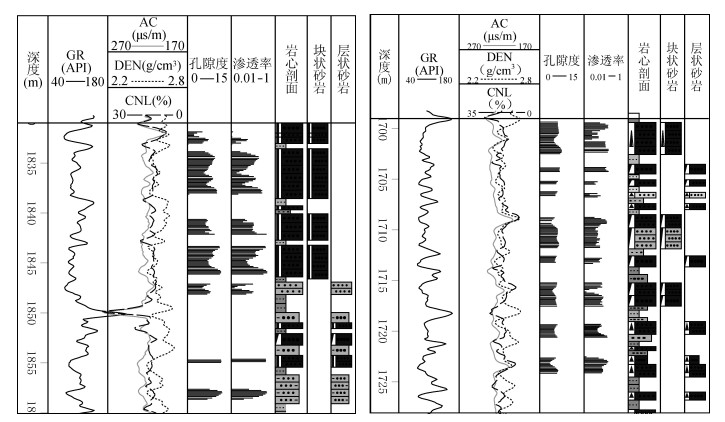
|
图 5 砂体结构特征 Figure 5 Sand body structure features |
为了定量刻画“块状砂体”厚度下限值,研究中依据长7单砂层试油资料,并统计其对应的单砂层厚度,得出单层砂体厚度与产液量关系图(图 6),结果表明:当单砂层厚度小于4 m时产液量明显降低;当单层砂层厚度大于4 m时,最大产液量与单砂层厚度基本上呈正向关系;单砂层厚度4 m处,是单砂层厚度与产液量关系发生变化的拐点.因此,将“块状砂体”单砂体厚度下限值定为4 m.另外,综合工业生产中单砂体厚度下限标准及单渗砂层能量厚度下限值(宋子齐等, 2011),将“层状砂体”单砂体厚度下限值定为2 m.
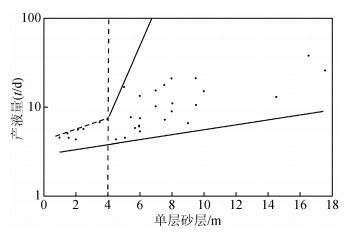
|
图 6 单层砂厚与产液量关系图 Figure 6 Relationship between thickness of single sand bodies and liquid production capacity |
常规测井曲线上“块状砂体”和“层状砂体”的测井响应特征均呈低自然伽马、低声波时差、低补偿中子、低光电吸收截面指数、自然电位明显负异常、高密度、缩径等特征;“块状砂体”曲线多为箱型、微齿化箱型,而“层状砂体”曲线多表现为钟型、微齿化钟型及漏斗型.而在岩心观察中一般将单砂层厚度大于4 m,或处于同一个沉积旋回内有多个砂层且单砂层厚度大于2 m,夹层厚度小于1 m,砂层厚度累加大于4 m的砂体作为“块状砂体”;将单砂层厚度大于2 m且小于4 m,或处于同一个沉积旋回内有多个砂层且单砂层厚度大于1.5 m,夹层厚度小于1 m,砂层厚度累加小于4 m的砂体作为“层状砂体”.
2.2 源储配置关系在烃源岩评价、砂体结构分析基础上,为了进一步搞清烃源岩品质、砂体结构、源储配置关系与含油性的关系,通过关键井及连井剖面分析,反映储层含油性与砂体结构、源储配置关系密切,图 7、图 8反映:
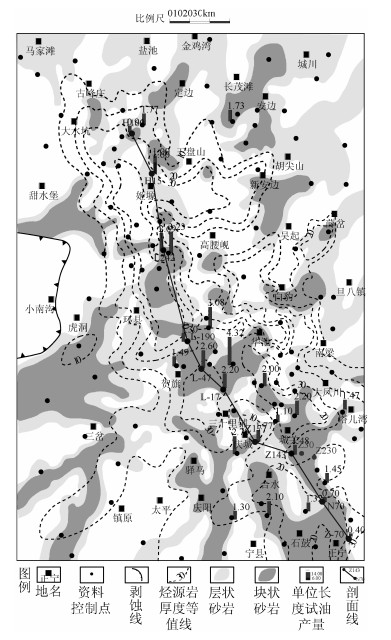
|
图 7 砂体结构展布与烃源岩叠置关系图 Figure 7 Different sands structure and source rocks stacked diagram |
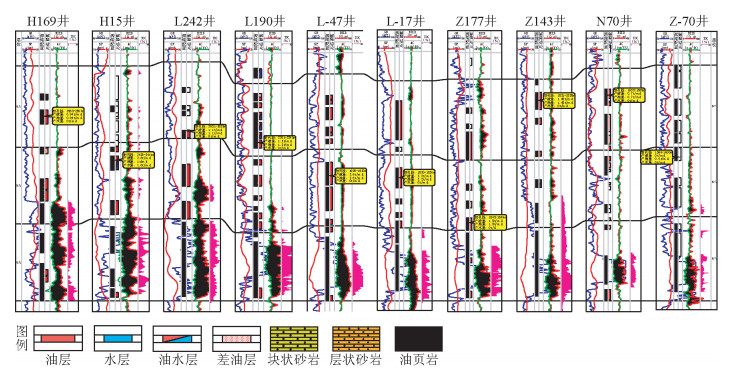
|
图 8 烃源岩品质、砂体结构及源储配置关系综合对比(剖面位置见图 7) Figure 8 Source rocks, sand body structure and source-reservoir configuration (Location of the section shown in Figure 7) |
(1) 烃源岩品质从盆地边部向盆地中心总体逐渐变好,TOC值从4%逐渐增大到10%以上,储层含油性从干层变为油层,每米日产油指数从0.94 t/m·d逐渐升高至2.6 t/m·d,每米日产油指数与烃源岩品质分布关系密切.
(2) 盆地中心部位为优质烃源岩(TOC>10%)分布区,紧邻烃源岩的块状砂体多为油层,而层状砂体含油性不均一,除油层外部分含油性为差油层,油气富集程度在块状砂体中明显高于层状砂体,试油结果显示块状砂体每米日产油指数一般达2.0 t/m·d,层状砂体每米日产油指数一般1.0 t/m·d左右;见图 7中L-47井-L-17井-Z177井-Z143井.
(3) 当砂体结构、烃源岩品质相同时,紧邻烃源岩的储集体单井每米日产油指数明显高于远离烃源岩储集体的产量,如L-17井每米日产油指数为2.2 t/m·d,Z143井每米日产油指数为1.48 t/m·d.
(4) 烃源岩品质很差时,即使发育紧邻烃源岩的块状砂体,由于没有充足的油源供给也不能成为油气富集区,常为差油层或干层,见图 7中Z177井-Z143井-N70井-Z-70井;在优质烃源岩发育区,油源供给充足,紧邻烃源岩的层状砂体一般也会形成油层或油水同层,距离烃源岩较远的块状砂体多为油层,如Z143井块状砂体部位每米产油指数可达1.0 t/m·d.
3 结论鄂尔多斯盆地长7段的烃源岩、砂体结构以及源储配置关系分析认为:
(1) 利用深感应电阻率(RILD)与声波时差(AC)重叠图技术,并结合自然伽马(GR)曲线可定性识别长7烃源岩;同时利用自然伽马、深感应电阻率、声波时差测井参数经多元回归后建立长7烃源岩定量解释模型,根据模型计算结果满足精度要求.
(2) 鄂尔多斯盆地烃源岩厚度一般5~70 m,TOC值一般2.0%~20.0%,烃源岩分布在平面上具有很强的非均质性.
(3) 鄂尔多斯盆地延长组长7段致密油分布在烃源岩内部或紧邻烃源岩的砂体之中.烃源岩品质、厚度、砂体结构及源储配置关系共同控制着致密油“甜点去”的分布,其中优质烃源岩发育区,块状砂体发育区和良好源储配置关系发育区是致密油优势富集区,每米日产油指数大于2.0 t/m·d;中等烃源岩发育区,块状砂体发育区以及烃源岩与储集层紧密接触区为致密油中等程度富集区,每米日产油指数为1.0~2.0 t/m·d;差烃源岩发育区,致密油富集程度较差,每米日产油指数小于0.5 t/m·d.
致谢 感谢西北大学大陆动力学国家重点实验室在论文完成过程中的帮助,感谢中国石油天然气股份有限公司重大科技专项“鄂尔多斯盆地致密油勘探开发关键技术研究” (2011E-2602)、陕西省重点学科“地质资源与地质工程”、河北省教育厅资助科研项目(QN2015255)联合资助.| [] | Deng J X, Zhou H, Wang H, et al .2015. The influence of pore structure in reservoir sandstone on dispersion properties of elastic waves[J]. Chinese J. Geophys., 58 (9) : 3389–3400. DOI:10.6038/cjg20150931 |
| [] | Fu Suotang, Deng Xiuqin, Pang Jinlian .2010. Characteristics and mechanism of thick sandbody of Yanchang Formation at the centre of Ordos Basin[J]. Acta Sedimentologica Sinica, 28 (6) : 1081–1089. |
| [] | HAO Jian-fei, ZHOU Can-can, LI Xia, et al .2012. Summary of shale gas evaluation applying geophysical logging[J]. Progress in Geophys., 27 (4) : 1624–1632. DOI:10.6038/j.issn.1004-2903.2012.04.040 |
| [] | JI Li-ming, WU Tao, LI Lin-tao .2007. Geochemical characteristics of kerogen in Yanchang Formation source rocks, Xifeng area, Ordos Basin[J]. Petroleum Exploration and Development, 34 (4) : 424–428. |
| [] | Jia Chengzao, Zou Caineng, Li Jianzhong, et al .2012. Assessment criteria, main types, basic features and resource prospects of the tight oil in China[J]. Acta Petrolei Sinica, 33 (3) : 343–349. |
| [] | Johnstone B. 2007. Bakken black gold[N]. Lesder-Poster, 12-10(6). |
| [] | LAI Jin, WANG Gui-wen, SUN Si-mian, et al .2015. Research advances in logging recognition and evaluation method of fractures in tight sandstone reservoirs[J]. Progress in Geophysics, 30 (4) : 1712–1724. DOI:10.6038/pg20150426 |
| [] | LI Shixiang, CHU Meijuan, HUANG Jinxiu, et al .2013. Characteristics and genetic mechanism of sandbody architecture in Chang-8 oil layer of Yanchang Formation, Ordos Basin[J]. Acta Petrolei Sinica, 34 (3) : 435–444. |
| [] | LIU Luo-fu, JIN Zhi-jun .2002. Distribution of major hydrocarbon source rocks in China's lager and medium-sized oil and gas fields[J]. Acta Petrolei Sinica, 23 (5) : 6–13, 18. |
| [] | Passey Q R, Creaney S, Kulla J B, et al .1990. A practical model for organic richness from porosity and resistivity logs[J]. AAPG Bulletin, 74 (12) : 1777–1794. |
| [] | Ren Zhanli .1999. Research on Geothermal History in Sedimentary Basins of the North China[M]. Beijing: Petroleum Industry Press . |
| [] | Song Zi-qi, Zhang Liang, Sun Bao-dian, et al .2011. Evaluation of favorable microfacies belts and division of effective thickness of reservoir by logging data[J]. Well Logging Technology, 35 (3) : 275–280. |
| [] | Sun Zandong, Jia Chengzao, Li Xiangfang, et al .2011. Unconventional Oil & Gas Exploration and Development (upper volumes)[M]. Beijing: Petroleum Industry Press : 1 -150. |
| [] | Wang Shaoyong, Li Jianzhong, Guo Qiulin, et al .2015. Application of AHP method to favorable area optimization for tight oil:A case study in Daanzhai Formation, Jurassic, central of the Sichuan Basin[J]. Advances in Eeath Science, 30 (6) : 715–723. |
| [] | Wang T S, Geng A S, Li X .2010. Pyrolysis of one crude oil and its asphaltenes:Evolution of gaseous hydrocarbons and carbon isotope[J]. Journal of Petroleum Science and Engineering, 71 (1-2) : 8–12. DOI:10.1016/j.petrol.2009.12.007 |
| [] | Wolela A .2007. Source rock potential of the blue nile (abay) basin, Ethiopia[J]. Journal of Petroleum Geology, 30 (4) : 389–402. DOI:10.1111/jpg.2007.30.issue-4 |
| [] | XIA Yi-jun, HU Xiang-yang, WEI Shui-jian .2015. Applications of geophysics in shale gas exploration and exploitation[J]. Progress in Geophysics, 30 (4) : 1798–1803. DOI:10.6038/pg20150437 |
| [] | Yang Tao-tao, Fan Guo-zhang, Lv Fu-liang, et al .2013. The logging features and identification methods of source rock[J]. Natural Gas Geoscience, 24 (2) : 414–422. |
| [] | Yao Jingli, Deng Xiuqin, Zhao Yande, et al .2013. Characteristics of tight oil in Triassic Yanchang formation, Ordos Basin[J]. Petroleum Exploration and Development, 40 (2) : 150–158. DOI:10.1016/S1876-3804(13)60018-X |
| [] | Zeng Jianhui, Yang Zhifeng, Feng Xiao, et al .2014. Study status and key scientific issue of tight reservoir oil and gas accumulation mechanism[J]. Advance in Earth Science, 29 (6) : 651–661. |
| [] | Zhang W Z, Yang H, Hou L H, et al .2009. Distribution and geological significance of 17α(H)-diahopanes from different hydrocarbon source rocks of Yanchang Formation in Ordos Basin[J]. Sci. China Ser. D-Earth Sci., 52 (7) : 965–974. DOI:10.1007/s11430-009-0076-1 |
| [] | Zhang Xiaoli, Shen Ying .1998. Study on the source rock of Jurassic coal measure strata in Tulufan-Hami basin by logs[J]. Well Logging Technology, 22 (3) : 183–185. |
| [] | Zhao Jingzhou, Li Jun, Cao Qing, et al .2013. Hydrocarbon accumulation patterns of large tight oil and gas fields[J]. Oil & Gas Geology, 34 (5) : 573–583. |
| [] | Zhu G Y, Gu L J, Su J, et al .2012. Sedimentary association of alternated mudstones and tight sandstones in China's oil and gas bearing basins and its natural gas accumulation[J]. Journal of Asian Earth Sciences, 50 : 88–104. DOI:10.1016/j.jseaes.2012.01.008 |
| [] | Zou Caineng, Zhu Rukai, Wu Songtao, et al .2012. Types, characteristics, genesis and prospects of conventional and unconventional hydrocarbon accumulations:taking tight oil and tight gas in China as an instance[J]. Acta Petrolei Sinica, 33 (2) : 173–187. DOI:10.1038/aps.2011.203 |
| [] | Zou C N, Zhu R K, Liu K Y, et al .2012. Tight gas sandstone reservoirs in China:characteristics and recognition criteria[J]. Journal of Petroleum Science and Engineering, 88-89 : 82–91. DOI:10.1016/j.petrol.2012.02.001 |
| [] | 邓继新, 周浩, 王欢, 等.2015. 基于储层砂岩微观孔隙结构特征的弹性波频散响应分析[J]. 地球物理学报, 58 (9) : 3389–3400. DOI:10.6038/cjg20150931 |
| [] | 付锁堂, 邓秀芹, 庞锦莲.2010. 晚三叠世鄂尔多斯盆地湖盆沉积中心厚层砂体特征及形成机制[J]. 沉积学报, 28 (6) : 1081–1089. |
| [] | 郝建飞, 周灿灿, 李霞, 等.2012. 页岩气地球物理测井评价综述[J]. 地球物理学进展, 27 (4) : 1624–1632. DOI:10.6038/j.issn.1004-2903.2012.04.040 |
| [] | 吉利明, 吴涛, 李林涛.2007. 鄂尔多斯盆地西峰地区延长组烃源岩干酪根地球化学特征[J]. 石油勘探与开发, 34 (4) : 424–428. |
| [] | 贾承造, 邹才能, 李建忠, 等.2012. 中国致密油评价标准、主要类型、基本特征及资源前景[J]. 石油学报, 33 (3) : 343–349. |
| [] | 赖锦, 王贵文, 孙思勉, 等.2015. 致密砂岩储层裂缝测井识别评价方法研究进展[J]. 地球物理学进展 : 1712–1724. DOI:10.6038/pg20150426 |
| [] | 李士祥, 楚美娟, 黄锦绣, 等.2013. 鄂尔多斯盆地延长组长8油层组砂体结构特征及成因机理[J]. 石油学报, 34 (3) : 435–444. |
| [] | 刘洛夫, 金之钧.2002. 中国大中型油气田的主力烃源岩分布特征[J]. 石油学报, 23 (5) : 6–13, 18. |
| [] | 任战利.1999. 中国北方沉积盆地构造热演化史[M]. 北京: 石油工业出版社 . |
| [] | 宋子齐, 张亮, 孙宝佃, 等.2011. 利用测井资料评价有利沉积微相带划分油层有效厚度[J]. 测井技术, 35 (3) : 275–280. |
| [] | 孙赞东, 贾承造, 李相方, 等.2011. 非常规油气勘探与开发(上册)[M]. 北京: 石油工业出版社 : 1 -150. |
| [] | 汪少勇, 李建忠, 郭秋麟, 等.2015. 层次分析法在致密油有利区优选中的应用-以川中侏罗系大安寨段为例[J]. 地球科学进展, 30 (6) : 715–723. |
| [] | 夏一军, 胡向阳, 魏水健.2015. 页岩气勘探开发中地球物理技术的应用[J]. 地球物理学进展, 30 (4) : 1798–1803. DOI:10.6038/pg20150437 |
| [] | 杨涛涛, 范国章, 吕福亮, 等.2013. 烃源岩测井响应特征及识别评价方法[J]. 天然气地球科学, 24 (2) : 414–422. |
| [] | 姚泾利, 邓秀芹, 赵彦德, 等.2013. 鄂尔多斯盆地延长组致密油特征[J]. 石油勘探与开发, 40 (2) : 150–158. |
| [] | 曾溅辉, 杨智峰, 冯枭, 等.2014. 致密储层油气成藏机理研究现状及其关键科学问题[J]. 地球科学进展, 29 (6) : 651–661. |
| [] | 张小莉, 沈英.1998. 吐哈盆地侏罗系煤系地层烃源岩的测井研究[J]. 测井技术, 22 (3) : 183–185. |
| [] | 赵靖舟, 李军, 曹青, 等.2013. 论致密大油气田成藏模式[J]. 石油与天然气地质, 34 (5) : 573–583. |
| [] | 邹才能, 朱如凯, 吴松涛, 等.2012. 常规与非常规油气聚集类型、特征、机理及展望-以中国致密油和致密气为例[J]. 石油学报, 33 (2) : 173–187. |
 2016, Vol. 31
2016, Vol. 31


